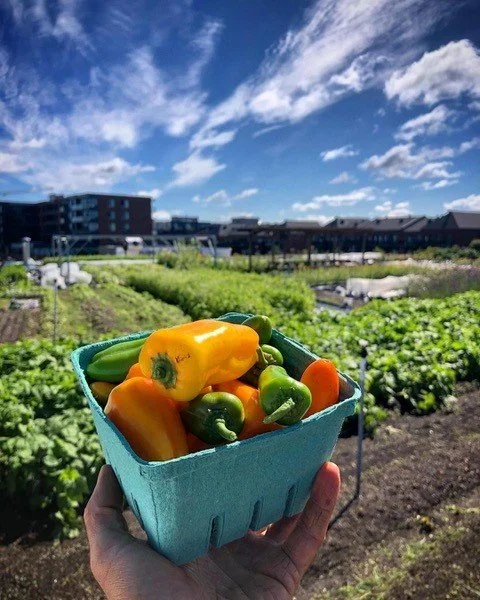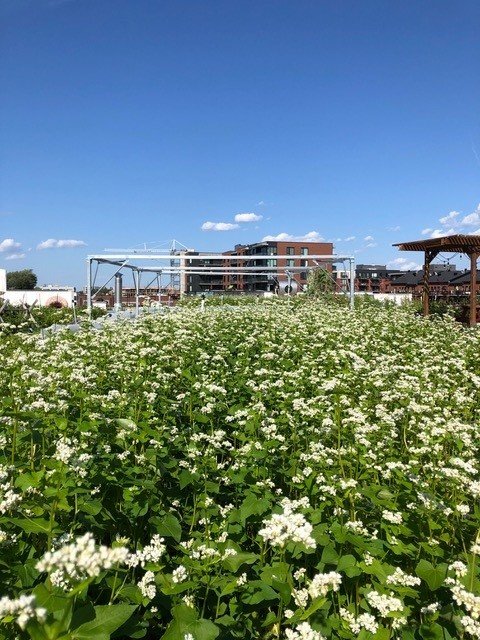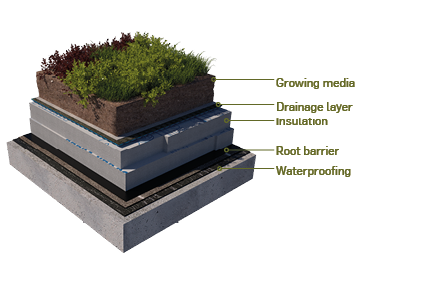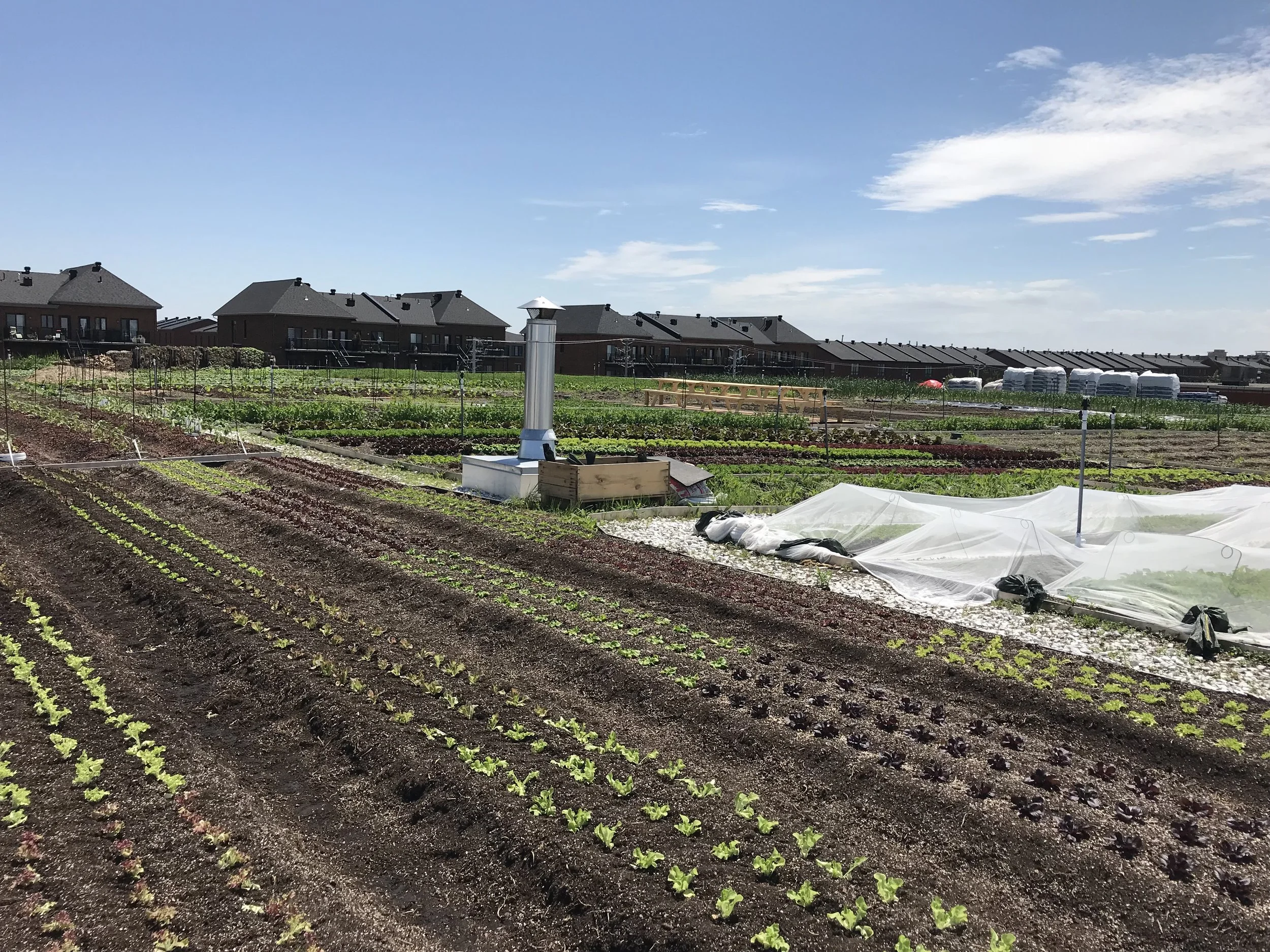The Inside Details on The Award Winning IGA Organic Rooftop Farm
Advertisement
Team Members
Green Roof Designer, Installer & Farmer: La Ligne Verte: Toits verts
Initial extensive green roof and building Architect: NEUF Architects
Owner: IGA Marché Duchemin et Frères inc.
Green Roof system Supplier: SOPRANATURE by Soprema
Category: Awards
Project: IGA Duchemin Urban Rooftop Farm
Location: Ville Sait-Laurent, QC
Award Winner: SOPRANATURE by Soprema
When you see the IGA’s rooftop farm, it’s hard to imagine that it came very close to never happening at all. If it hadn’t been for the visionary output of La Ligne Verte’s co-founders Antoine Troitter and Patrice Godin, this project would have been a four-inch sedum mat extensive green roof. Not that this would have been a bad thing in itself, but we will all agree that it would have been very far from the iconic rooftop farm it has now become. The neighborhood where the grocery store is located is Ville Saint-Laurent, on the Island of Montreal. This neighborhood’s regulations require new roofs to be either green or reflective (white) and this specific project was required to have 50% of the building roof area covered with a green roof system. To meet this requirement, a simple extensive sedum roof was designed and the bidding process went out as such. The project was awarded to La Ligne Verte, who were able to convince the IGA’s owner of the added value of investing in a large scale urban rooftop farm. The roof was also redesigned to highlight the IGA logo and that is represented in the shape of the green roof.
Birds view of the IGA rooftop farm. Photo: La Ligne Verte
When the Duchemin family partnered with La Ligne Verte they didn't think the project would have such a big impact. The rooftop farm gained a lot of attention in the media across North America and even across borders, being published in many countries throughout the world.
Many professionals were involved in this Green Roofs for Healthy Cities’ Awards of Excellence winning project: SOPREMA, NEUF Architectes, Le Groupe Mach and Sobeys are just a few of the stakeholders who participated. The entire concept was brought forth and happened as a result of the involvement and persistence of La Ligne Verte, the local Montreal company that incorporated a very creative solution- based approach to this project.
Advertisement
Photo: La Ligne Verte
IGA Duchemin is now the first grocery store in Canada to sell fresh organic produce harvested directly from its roof. Here are a few interesting facts about the project:
More than 30 kinds of vegetables are produced on the roof; i.e. kale, lettuce, carrots, green beans, eggplant, garlic, tomatoes, spinach and more.
There is a very productive cut flower activity going on, on the roof.
Vegetables and flower bouquets are sold in the IGA below.
Eight newly installed beehives on the roof produced 500 jars of honey in 2021
35 000 to 40 000 units of vegetables and flowers sold annually (ex: one unit is a carrot bunch, a leafy green bin, an eggplant etc..) That is approximately 7.2 tons of harvested produce, out of which more that 1.3 tons are leafy greens.
The farm requires 3 full time farmers (one full time year round 2 full time seasonal) and they also employ 6 interns and over 10 volunteer workers every summer.
“Over the years, we conducted trials with nearly all kinds of vegetables. We were able to successfully grow crops that you wouldn’t expect on a roof such as broccolis, cauliflowers, parsnips, carrots, cabbages, melons and artichokes. Although these crops have mostly been experimental, we now focus on lower maintenance crops with high economic value such as greens, small roots (turnips, radishes), and cherry tomatoes… because who doesn’t love fresh garden cherry tomatoes.”
Advertisement
Photo: La Ligne Verte
The only means of transportation used to get from the roof to the market are walking with it the forty-four steps in the staircase that connects the farm to the back of the store. All fresh produce sold in the IGA gives nearby residents a local source of extremely fresh, organic food. Being able to integrate urban greening strategies and green infrastructure solutions to an otherwise common building can also contribute to preventing the risks related to certain physical and/or mental diseases. These projects can also improve lifestyle and increase the well-being of individuals and that is even more relevant because rooftop farms touch the food that we consume daily.
A dinner on top of the IGA farm. Photo: Roxanne Miller
Harvesting locally grown produce reduces the ecological and economical impacts of long-distance freight. This rooftop allows us to cultivate fruits and vegetables that are not usually cultivated in the urban environment of Montreal. One of the biggest advantages of a rooftop farm is the very good drainage of the soil and the fact that the “field” is workable very early in the spring. That gives the farmers a much needed head start, letting them seed a lot of crops very early in the season. These specific conditions provide growing conditions that allow the team to harvest garlic nearly a month before most other farms in Québec. The team is always amazed to harvest huge cloves at the end of June.
The building is owned by IGA and the farm is rented by La Ligne Vert which generates revenues from the sale of produce. In order to gain more revenue and promote the farm, rooftop dinners and brunches are also organized on the roof's amenity spaces, and the dishes are cooked with fresh food from the roof.
The waterproofing system was initially designed and installed as an inverted single ply assembly, with membrane protection needed for a green roof installation. As this project evolved into a rooftop farm it had to sustain a lot of foot traffic and farming activities, so the inverted roofing assembly became even more crucial to protect underlying waterproofing. This inverted assembly as well as the SOPRANATURE green roof system together, apart from protecting the waterproofing from any physical harm, add an extra layer of insulation, which reduces the store's electrical consumption. The XPS insulation being laid on top of the waterproofing also ensures that no farming tool can reach the waterproofing. This is because it adds a very strong physical barrier protection.
SOPRANATURE’s semi-intensive systems are mid-light green roofs ranging from 150 mm to 300 mm dept of SOPRAFLOR growing media. Plant types typically include sedums, grasses, perennials, shrubs and edibles. These are the systems that are preferred for urban rooftop agriculture. Typically, green roof media has a very low organic content to ensure minimal maintenance, adequate drainage and minimize the compaction. These types of growing media are not adequate for food production and need to be adapted to support vegetable growth. Active monitoring and adjustments over the course of four years supported the development of new organic green roof soils specifically designed for vegetable production on green roofs. The growing media at IGA, after a few years of farming, now contains approximately 35 per cent or organic matter by volume. This specific growing media blend is certified Ecocert, and allows for food produced to be certified as organic.
Advertisement
3D rendering of inverted system. Photo: SOPRANATURE
Irrigation was also key in the project’s success and IGA Duchemin is the very first Canadian store to use an irrigation system partially based on the recovery of water from its air conditioning system. Even though SOPRANATURE systems have a capacity of absorption, retention and filtration of water, a rooftop farm still requires frequent irrigation to ensure maximum yields. As with any green roof, the rooftop farm still improves stormwater management while helping to reduce the risks associated with overflows and floods. The irrigation system takes into account rain episodes and is triggered as needed in order to use as little potable water as possible. The store itself is LEED Gold certified, one of the highest standards for green buildings.
SOPRANATURE systems create conditions promoting the development of microhabitats to support life and the roof is home to different pollinators and nesting birds. The flowering plants on the roof look as beautiful as they are useful! The rooftop farm has been such a great addition to the store’s image and revenues that the owners have expanded the farm by an additional 5,000 square feet to the existing 25,000 square feet in the fall of 2021.
With the growing awareness that food supply must not be taken for granted anymore, let’s hope that this successful project inspires others to invest in their community’s future and well being.
A closer look at the IGA rooftop. Photo: Roxanne Miller
“You would expect a rooftop farm to be free of most pests typically encountered in the countryside. However, despite our urban location, we do struggle with the same weeds, insects and some fungal diseases from time to time as any other farm. However, most of these problems are kept under control even under organic management by implementing preventive strategies. If it was too easy, it would be boring, right?”
“As an organic vegetable farmer coming from a rural background, I was skeptical that a rooftop farm could be productive given the very shallow depth of soil. It turns out that there are many advantages to a rooftop farm. Amongst others, a perfect light exposure, the absence of deer and other small mammals, and near-perfect “field” conditions very early in the season. Combined with beneficial farming practices such as cover crops, green manure, minimum soil disturbance and regular additions of compost, we created an urban farm with a true living soil where insects, worms and bacteria are thriving and make our system truly productive.”
A short video on the IGA farm.
Advertisement
Roxanne Miller, Directrice at SOPRANATURE® Canada, has been intimately involved in the award winning IGA Duchemin rooftop farming project and has worked on green roofs in Quebec and across Canada.










